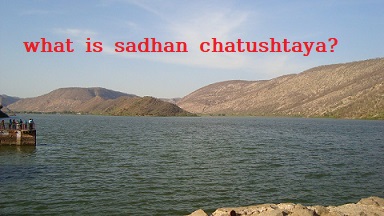Sadhan Chatushtaya (साधन-चतुष्टय)
Sadhan Chatushtaya (साधन-चतुष्टय) is referred as group of four means (चतुष्टय) which lead to the path of Self-Realization, where one can figure out his true nature as Atman.
As mentioned by Adi Shankaracharya himself in Vivekachudamani , verse 18
साधनान्यत्र चत्वारि कथितानि मनीषिभिः ।
येषु सत्स्वेव सन्निष्ठा यदभावे न सिध्यति ॥
Sages has uttered the four means () by following which one understand the Atman, and in the absence of which, he doesn’t.
Four elements of Sadhan Chatushtaya
Adi Shankaracharya mentioned the same in Vivekachudamani verse 19 :
आदौ नित्यानित्यवस्तुविवेकः परिगम्यते ।
इहामुत्रफलभोगविरागस्तदनन्तरम्
शमादिषट्कसम्पत्तिर्मुमुक्षुत्वमिति स्फुटम् ॥
- Viveka (नित्यानित्यवस्तुविवेक) – Discrimination between the real and unreal.
- Vairagya (वैराग्य) – Dispassion to the enjoyments of the fruits of actions.
- Shamadi Sampatthi (शमादिषट्कसम्पत्ति) :
- Sama (शम) : Mind control
- Dama (दम) : Control of senses
- Uparati (उपरति) : Perform your duties & renounce other actions
- Titiksha (तितिक्षा) : Staying neutral in good or bad situation
- Shraddha (श्रद्धा ) : conviction in shastras & teacher
- Samadhana (समाधान) : One pointedness of mind
- Mumukshutwa (मुमुक्षुता) : Yearning for liberation.
Viveka (नित्यानित्यवस्तुविवेक)
ब्रह्म सत्यं जगन्मिथ्येत्येवंरूपो विनिश्चयः ।
सोऽयं नित्यानित्यवस्तुविवेकः समुदाहृतः ॥ – Vivekachudamani verse 20
A firm conviction of the mind that Brahman is real and the universe unreal, is called as Viveka between the Real and the unreal.
Vairagya (वैराग्य)
तद्वैराग्यं जिहासा या दर्शनश्रवणादिभिः ।
देहादिब्रह्मपर्यन्ते ह्यनित्ये भोगवस्तुनि ॥ – Vivekachudamani verse 21
Desire to give up transient enjoyment gained through seeing or hearing: and experiences which are gained thought this physical body or achieved in other lokas ( bhramloka e.t.c ) is called as ‘Vairagya’
Sama (शम:)
विरज्य विषयव्राताद्दोषदृष्ट्या मुहुर्मुहुः ।
स्वलक्ष्ये नियतावस्था मनसः शम उच्यते ॥ – Vivekachudamani verse 22
The resting of the mind on its goal, after having detached itself from sense-objects by continually observing their defects, is called ‘Śama’.
Dama (दमः) and Uparati (उपरति)
विषयेभ्यः परावर्त्य स्थापनं स्वस्वगोलके ।
उभयेषामिन्द्रियाणां स दमः परिकीर्तितः
बाह्यानालम्बनं वृत्तेरेषोपरतिरुत्तमा ॥ – Vivekachudamani verse 23
Turning both kinds of sense-organs away from sense-objects and placing them in their respective centres, is called Dama . Uparati or self-withdrawal consists in the mind-function ceasing to act by means of external objects.
Titiksa (तितिक्षा)
सहनं सर्वदुःखानामप्रतीकारपूर्वकम् ।
चिन्ताविलापरहितं सा तितिक्षा निगद्यते ॥ – Vivekachudamani verse 24
Capacity to endure sorrow and suffering without redressing them is called Titiksa
Sraddha (श्रद्धा)
शास्त्रस्य गुरुवाक्यस्य सत्यबुद्ध्यवधारणम् ।
सा श्रद्धा कथिता सद्भिर्यया वस्तूपलभ्यते ॥ – Vivekachudamani verse 25
Acceptance by firm judgment as true of what the Scriptures and the Guru teaches, is called Sraddha, by means of which the reality is perceived.
Samadhana (समाधान)
सर्वदा स्थापनं बुद्धेः शुद्धे ब्रह्मणि सर्वदा ।
तत्समाधानमित्युक्तं न तु चित्तस्य लालनम् ॥ – Vivekachudamani verse 26
Not the mere indulgence of thought but the constant concentration of the intellect on the ever-pure Brahman, is what is called Samadhana
Mumuksuta (मुमुक्षुता)
अहंकारादिदेहान्तान् बन्धानज्ञानकल्पितान् ।
स्वस्वरूपावबोधेन मोक्तुमिच्छा मुमुक्षुता ॥ – Vivekachudamani verse 27
Mumuksuta is the desire to free oneself, by realising one’s true nature, from all bondages from that of egoism to that of the body.



















